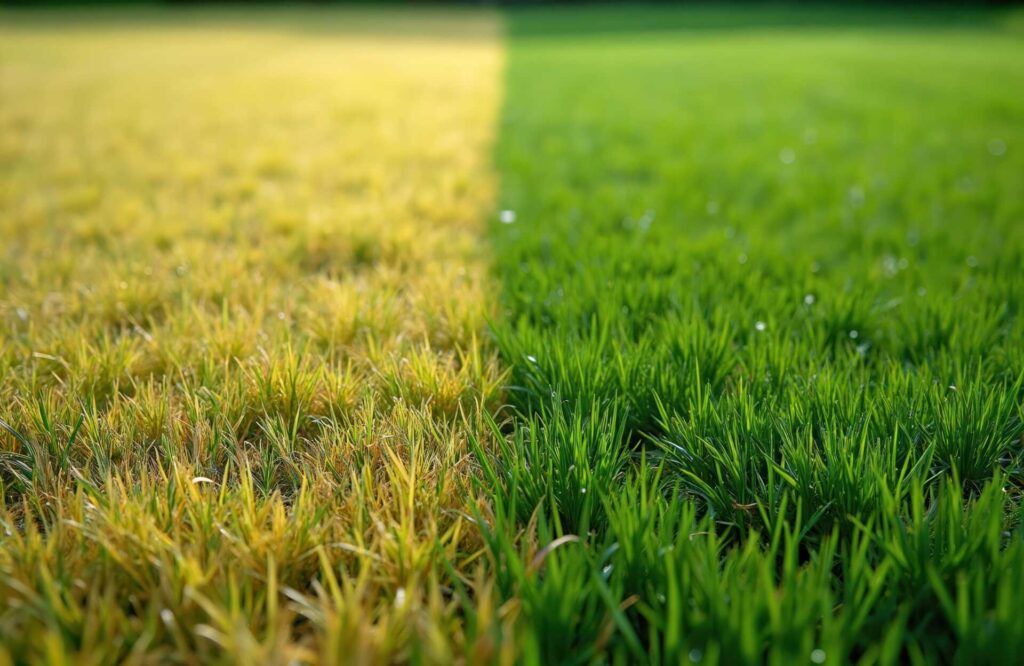
Contents
To achieve ideal grass health, understanding seasonal fertilization techniques is essential. Each season presents unique challenges and opportunities for your lawn’s nutrient needs. By implementing tailored strategies for spring, summer, fall, and winter, you can greatly enhance your turf’s resilience. But, there’s more to take into account—timing plays a vital role in your fertilization success. How can you ensure your lawn thrives throughout the year?
Key Takeaways
- Conduct soil testing in early spring to determine nutrient needs and pH levels for effective fertilization.
- Apply slow-release fertilizer in summer to support growth while minimizing the risk of burning the grass.
- Fertilize in fall with a high-nitrogen blend to enhance root growth and prepare grass for winter.
- Use soil amendments like compost in winter to improve soil health and nutrient availability for spring growth.
- Monitor weather conditions and soil temperatures to time fertilization with active grass growth periods.
Spring Fertilization Techniques for Healthy Growth
As spring arrives, you need to focus on fertilizing your lawn to promote healthy growth and lush greenery.
Start by conducting soil testing to understand your soil’s pH and nutrient levels. This critical step allows you to identify deficiencies and tailor your fertilization strategy accordingly. A thorough nutrient analysis will reveal specific needs, enabling you to choose the right fertilizer blend—whether it’s nitrogen, phosphorus, or potassium-rich.
Once you’ve assessed your soil, apply a slow-release fertilizer to provide a steady supply of nutrients throughout the growing season.
Timing is essential; fertilize when the grass starts actively growing, usually in mid to late spring. Be mindful of weather conditions, as rain can help the fertilizer penetrate the soil effectively.
Remember, a well-fertilized lawn enhances aesthetic appeal and strengthens your grass against pests and diseases.
Embrace these techniques for a thriving, healthy lawn.
Summer Care: Balancing Fertilization and Heat Stress
While summer brings warmth and longer days, it also presents challenges for maintaining a healthy lawn, especially when balancing fertilization and heat stress. Effective heat management is essential during this season, as high temperatures can hinder nutrient uptake, leading to potential deficiencies in your grass.
To navigate this, consider applying a slow-release fertilizer that aligns with your lawn’s growth cycle. This method provides a steady flow of nutrients, minimizing the risk of burning the grass under the intense sun.
Additionally, watering practices play an important role. Aim for deep, infrequent watering to encourage root development, which aids in heat resilience. Early morning is often the best time to water, reducing evaporation losses.
Fall Fertilization for Winter Preparation
To prepare your lawn for the winter months, timely fall fertilization is essential. This process supports nutrient uptake and enhances soil amendments, ensuring your grass emerges healthy in spring. Apply a high-nitrogen fertilizer to promote root growth before the ground freezes.
| Nutrient | Purpose |
|---|---|
| Nitrogen | Stimulates growth and vigor |
| Phosphorus | Encourages root development |
| Potassium | Builds drought resistance |
| Soil Amendments | Improves soil structure and fertility |
Winter Strategies to Enhance Soil Health
Implementing winter strategies to enhance soil health can considerably improve your lawn’s resilience for the upcoming growing season. One effective approach is to apply soil amendments like compost or well-rotted manure. These organic materials enrich the soil, providing essential nutrients and improving its structure.
Additionally, consider planting winter cover crops, such as rye or clover. These crops prevent soil erosion and enhance nutrient availability through nitrogen fixation and organic matter when tilled back into the soil.
Together, soil amendments and winter cover crops create a thriving ecosystem that supports beneficial microorganisms, crucial for soil health.
As you prepare for winter, actively engage with these strategies to nurture your lawn’s foundation. By investing in soil health now, you’re setting the stage for a lush, vibrant lawn that will flourish in spring.
Join fellow lawn enthusiasts in this commitment to sustainable practices, and watch your efforts pay off!
Timing Your Fertilization for Optimal Results
Timing your fertilization is essential for achieving ideal results in lawn care. To ensure your grass thrives, start with pre-fertilization testing. This process gives you a clear understanding of your soil’s nutrient needs and pH levels, helping you choose the right fertilizer.
Next, consider weather considerations. Fertilizing during a period of growth, typically in spring or early fall, maximizes nutrient uptake. However, avoid applying fertilizer before a heavy rain, as it can wash away essential nutrients. Instead, wait for dryer conditions to prevent runoff and ensure absorption.
Additionally, keep an eye on soil temperatures; they should be warm enough to promote active growth. By synchronizing your fertilization with these factors, you’ll cultivate a robust lawn that looks great and thrives through the seasons.
Summary
Think of your lawn as a thriving ecosystem where each season plays an essential role in its overall health. By following these seasonal fertilization strategies, you’re not just feeding your grass; you’re nurturing a resilient environment that can withstand challenges year-round. Remember, timing is everything. Monitor conditions closely, and your lawn will flourish like a well-tended garden, ready to bounce back stronger with each passing season.
Recent Posts
3 Best Weed Control Techniques for Grand Rapids Lawns
Many homeowners underestimate the importance of a strong grass foundation in weed control. A healthy
5 Tips for Managing Weeds in Grand Rapids Lawns
Managing weeds in Grand Rapids lawns can be a challenge, especially with the diverse range
Top 10 Weed Management Tips for Grand Rapids Lawns
Managing weeds in your Grand Rapids lawns requires a strategic approach. By understanding the common